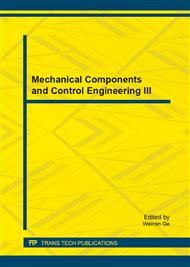p.973
p.977
p.981
p.985
p.990
p.994
p.999
p.1003
p.1007
The Study of Four-Position North Seeking System under Vibration Environment
Abstract:
In order to develop north seeking system with strong anti-interference ability, the influence caused by the swaying base on the performance of north seeker was investigated. The influence of sinusoidal signal of gyros and tilt sensor's output was analyzed based on four-position north seeking system which was consisted of a single axis gyro and a tilt sensor. Fiber optic gyros and tilt sensor are interference by the same vibration signal, according to the relationship between the output signal of gyro and the angle sensor, a PI controller was designed to compensate the gyro's output error. This real time compensation can effectively improve the north seeking accuracy and speed without complicated calculation or external reference signal. The north seeking accuracy is better than 0.03o. Simulation and actual north seeking result proved that this method significantly improves the north seeking performance in vibrant environment.
Info:
Periodical:
Pages:
990-993
Citation:
Online since:
October 2014
Authors:
Price:
Сopyright:
© 2014 Trans Tech Publications Ltd. All Rights Reserved
Share:
Citation:


